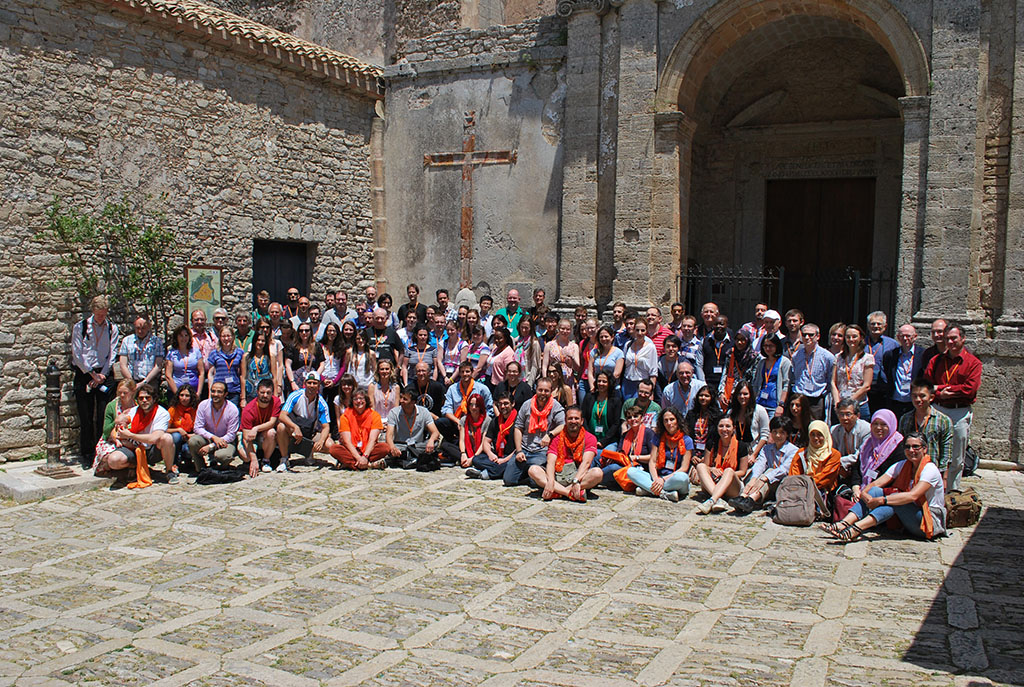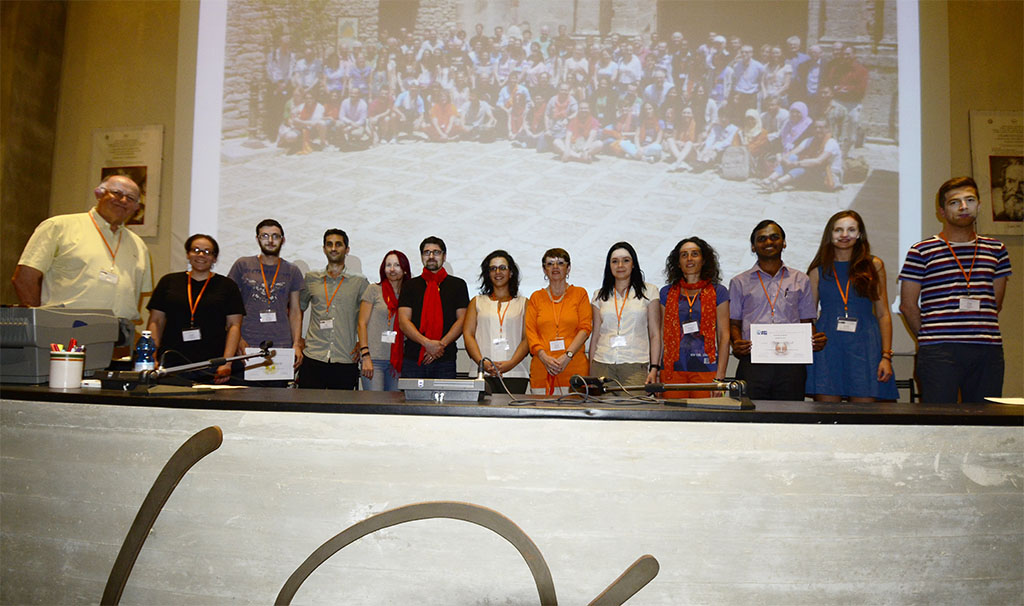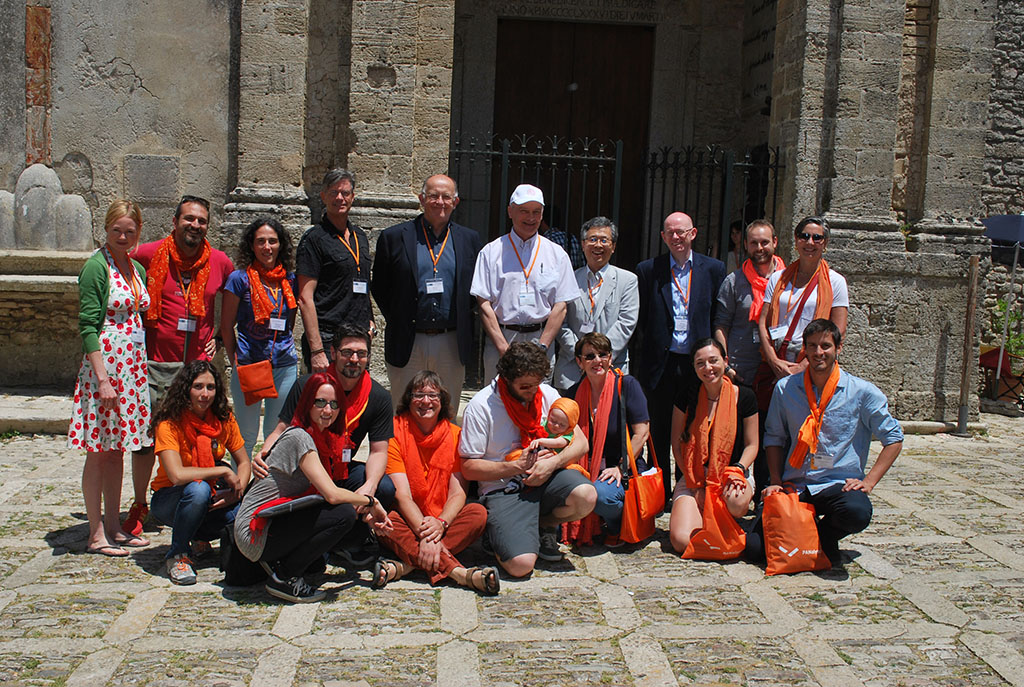
Click on the photo for a printable version
Report
International School of Crystallography
48th Course – Engineering Crystallography: from Molecule to Crystal to Functional Form
5 to 14 June, 2015
The 48th Course of the International School of Crystallography “Crystal engineering: from Molecule to Crystal to Functional form” was held from 5 to 14 June 2015 in Erice, Italy at the Ettore Majorana Foundation and Centre for Scientific Culture. Participants were selected among the many applications that were received in the following months. The large number as well as the outstanding quality of the applications made this process quite difficult, but in the end approximately 80 students were accepted for the Course. Participants were largely from universities (PhD students, post-docs and young researchers), with some members of chemical and pharmaceutical companies.
The course design was to broadly focus on the core experimental activities associated with the molecular to crystal transition in the first half and the associated workflows with the link between crystal and functional form in the latter half of the school. In the middle of the week it was our intention to introduce the core computational concepts supported with tutorials in the penultimate day. Throughout the course there was ample time for students to ask questions and engage in discussions. On the final day, a panel session was designed to specifically reinforce and consolidate the learning experience from the course, where students were able to question a subset of the lecturers with both pre-submitted questions and questions arising in the facilitated discussions,
The programme contained about 50 lectures, including 6 chosen from poster abstracts submitted by participants. In addition, there were 2 software tutorials and 1 equipment demonstration (each repeated twice).
The first day provided a complete overview of the school objectives and the overall plan for the summer school (Roberts). The opening talk (Docherty) presented the translation of molecule to crystal to product in the pharmaceutical sector. This was followed up by a lecture on supramolecular assembly and solid form architecture (Aakeroy) and in the following talk the link between the crystal structure and mechanical properties of organic materials was highlighted (Malla-Reddy). In the afternoon of day 1 the crystallization route map was introduced (Roberts) and the importance of supersaturation as the driving force for nucleation and growth was comprehensively covered (ter Hoorst). The importance and influence of interfaces during the crystal growth process was elegantly captured (Ward). As the school proceeded into days 2 and 3 the additional concepts of morphology and chirality were introduced. The link between growth and habit/morphology was covered in detail (Roberts). The definition of molecular chirality and the importance of the resolution of chiral molecules (Kuroda, Tamura, Coquerel) were introduced to the participants in a series of connected lectures on the first and second and fourth days. On the afternoon of day 2 the theme of stability was introduced first focusing on chemical reactivity and crystal defects (Jones) and then the physical stability of polymorphs and solvates (Griesser). On days 3 and 4 we had begun to introduce molecular and solid state modelling techniques as part of the school. Molecular to crystal modelling techniques we described in detail (Hammond) and then solid state computational modelling including crystal structure prediction were overviewed (Cruz- Cabeza). This was extended further reviewing the information available in the Cambridge Structural Database (CSD) and the impact of solid state informatics on solid state structure design (Feeder). Additional talks on phase diagrams (Coquerel) and chiral liquid crystals (Tamura) reinforced some of these topics from day 1 and 2 and the impact of solid state architecture on energetic materials was elegantly covered (Aakeroy). Further through the course we introduced crystallization manufacturing basic concepts, modelling and control. On day 5 through two talks from leading exponents in the field we introduced crystallization process modelling concepts (Mazzotti) and crystallization process control (Nagy). We also introduced different crystallisation processes for production such as evaporation and cooling (Myerson) as well as the comparing and contrasting batch and continuous processing (Price). On day 5 and 6 we also introduced Discrete and Finite Element Modeling (DEM/FEM) to allow the connection between the particles formed in primary manufacturing and their possible impact on secondary processing (flow, mixing) (Wu). On day 5 and 6 we also extended work on solution and solid state characterization (Kwokal) as well as co-crystal formation through grinding (Jones). On day 6 we targeted solid state and surface characterization (Feeder, Heng) and then crystallization screening and process scale up (Griesser and Nagy). This was followed with the software tutorials (Mercury by the CCDC and Visual Habit from Leeds University) and the Crystal 16 crystallization workflow (Avantium). These were very popular session with a highly level of engagement and enthusiasm from the participants The final day consisted of an overview of analytical technology applied to crystallisation and powders (Kwokal) and to crystal optical characterization (Kuroda) plus the application of ultrasound to induce nucleation (Price). The formal teaching was concluding with the deconstruction of a product back to components parts and the impact of science of scale tools on product design (Docherty). The final afternoon was dedicated to a panel where students could question seven of the speakers on all aspects of the course in a highly interactive way. The students had throughout the week submitted questions ahead of the panel so as broad themes could be identified and used to catalyze themes.
The participants presented about 70 posters on display on day 2 and day 5. The presentation consists of half the posters hanged, each day, with a session over the lunch break and a more formal viewing ahead of the evening dinner. The two poster sessions were organized in the evening, starting before and continuing during dinner time. The “poster preview during lunch” session already experimented with last year was implemented again this year and was very successful and appreciated by poster presenters.
Six fifteen-minute oral presentations by young participants (selected from the poster abstracts) were also included in the program: Thomas Gee (University of Southampton), Fanny George (Univesité Catholique de Louvaine), Gareth Lloyd (Heriot-Watt University), Marlena Gryl (Jagiellonian University), Anaelle Tilborg (Univeristy of Namour) and Martin Viertelhaus (BASF SE). To further promote interactions among participants, several general events were organized during the day and in the evenings.
A book containing the lecture notes written by the Invited Speakers, the poster abstracts and pictures of all participants was distributed to the students upon arrival in Erice. This has been proved to be an extremely valuable resource to both students and lecturers. The publishers will soon receive the final version, in order to produce the book within the next six to nine months.
The link to a web-based questionnaire was emailed to all participants before the end of the school in order to assess the perceived quality of the course and to improve subsequent courses.
Awards and participant Feedback
In the afternoon of the last day (June 13th) several awards were appointed during the closing ceremony. Since the number of the posters presented was large, two different categories were chosen (based on the number assigned to the poster, odd or even): the first places were assigned to Stuart Kennedy (Durham University, UK) and Ran Drori (New York University, US); Filip Topi? (University of Jyvaskyla, Finland) and Isabel Olson (New York University, US) were awarded of the second places and the third prizes were conferred to Sameer Modi (NIPER, India) and Anneke Klapwijk (University of Bath, UK).
The Lodovico Prize (acknowledging the most active student inside and outside the lecture hall) was given to Elena Meirzadeh (Weizman Institute of Science, Israel). Moreover a special mention for the Lovico Prize was assigned to Marlena Gryl (Jagiellonian University, Poland). Enclosed a picture of the prize winners.
At the end of the Course, participants were asked to participate to a survey to judge and comment on the quality of the Course. Their responses indicates that a similar meeting should be held at least in 3-4 year time and that the course have been successful in most of its objectives (score 85/100).

Click on the photo for a printable version
Picture of the winners, from left to right:
Prof. Kevin Roberts (University of Leeds, UK), Isabel Olson (NYU, US), Stuart Kennedy (Durham University, UK), Ran Drori (NYU, US), Erin Davis and Fred Boyle (IT experts), Elena Meirzadeh (Wiezmann Institute, IL), Paola Spadon (University of Padua, IT), Marlena Gryl (Jagiellonian University, PL), Annalisa Guerri (University of Florence, IT), Sameer Modi (NIPER, IND), Anneke Klapwijk (University of Bath, UK) and Filip Topi? (University of Jyvaskyla, SF).

Click on the photo for a printable version
Directors of the 48th Course “Crystal Engineering: from Molecule to Crystal to Functional Form”.
From left to right standing: Tamlyn Young, Fabio Nicoli, Annalisa Guerri, Christer Aakeroy, Kevin Roberts, Gerard Coquerel, Rui Tamura, Robert Docherty, Paolo Pio Mazzeo and Giovanna Scapin. Sitting, from left to right: Vania André, Erin Davis, Fred Boyle, Martin Schmidt, Matteo Lusi, Giorgio Lusi, Paola Spadon, Valentina Marcheselli and Francesco Farinella.